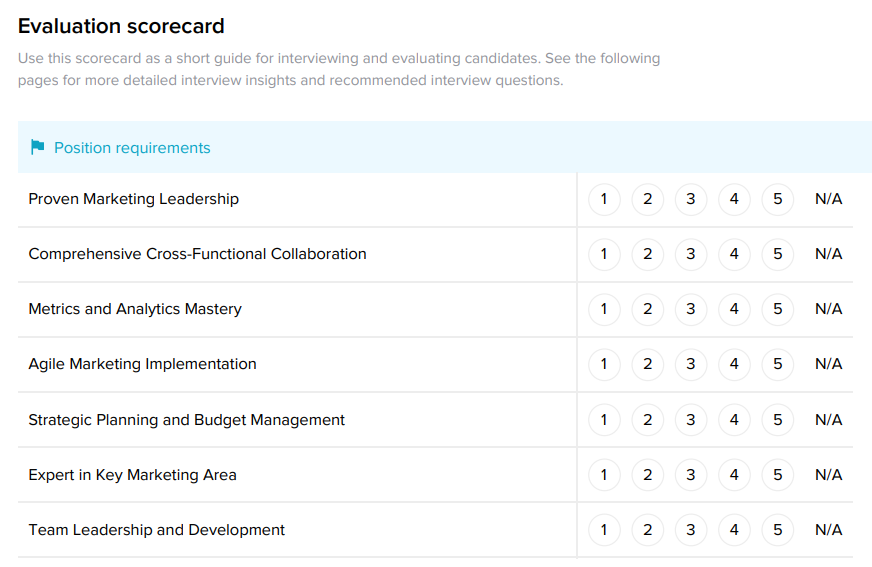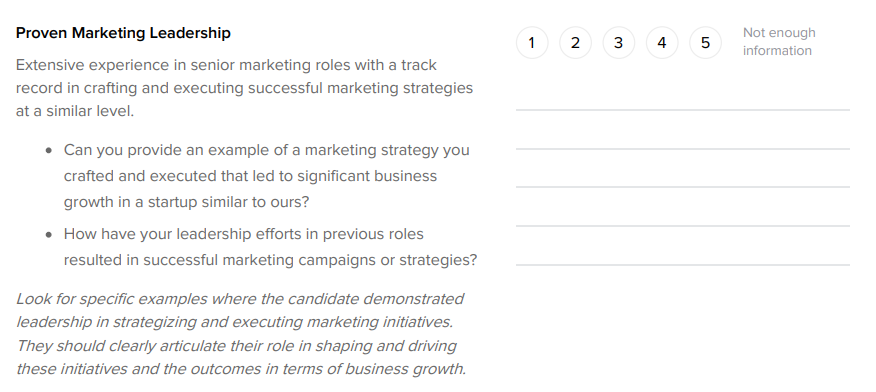What are hiring scorecards
Understand the key objectives, position requirements, and work-related competencies that make up a hiring scorecard.
Hiring scorecards are the foundation of an effective hiring process. A comprehensive and systematic method for evaluating candidate suitability for a position with clear, defined goals and an established structure.
Essentially, they are a series of criteria with specific questions to check whether a candidate matches the criterion or not. Each criterion is evaluated separately, and the scores added up to give an overall score for each candidate.
Scorecards create a level playing field for all candidates - everyone will be evaluated based on the same criteria and scored on their individual answers. And they give hiring managers a clear and focused overview of the candidates and how they compare against each other.
What's in a scorecard
Generally, a hiring scorecard contains three primary sections. The first section outlines the key objectives that the candidate should be able to fulfil.
The second section concentates the position requirements, including essential qualifications, skills, and experience needed to achieve the objectives.
And the final section focuses on work-related competencies, which are the behavioural attributes vital for successful performance in the role.
Understanding Key Objectives
A hiring scorecard is akin to a well-crafted map, and the Key Objectives can be thought of as the treasure markers on this map. They represent the primary goals a candidate must meet to successfully fulfill their role.
When looking at a scorecard, it's essential to correctly interpret these objectives and make sure they align with the company's specific needs.
To ensure this match, you need to analyse and contextualise the objectives carefully. Break down each objective and consider its relevance to the organisation's larger goals.
An open conversation with key stakeholders can help ensure that your interpretation of the objectives aligns with the company's broader perspective.
Example: Deals are moved through each sales pipeline stage following a consistent and predictable process.
Utilising Position Requirements
Position Requirements are the essential qualifications, skills, and experiences that a candidate needs to accomplish the key objectives. Think of these requirements as the tools that will allow your candidate to unearth the treasure marked by the Key Objectives.
To leverage these position requirements effectively, you need to use them as a measuring stick against the job description and candidates' resumes. This evaluation will give you an initial understanding of how well a candidate fits the role.
Furthermore, these requirements can be invaluable in formulating relevant questions for the interview process. Framing questions around these requirements will allow you to probe more deeply into a candidate's suitability for the role.
Example: Sales Process Discipline - Demonstrated ability to methodically move deals through the sales pipeline using a CRM, adhering to a structured and repeatable process.
Leveraging Work-Related Competencies
Competencies represent the behavioral attributes required for success in the role. You can think of them as the character traits that will enable the candidate to face the challenges that come with the role effectively.
Understanding these competencies is crucial as they provide a lens through which you can assess a candidate's potential for success in the role.
During interviews, keep an eye out for signs that candidates exhibit these competencies. Additionally, these competencies can help in designing assessment tasks or situational interview questions.
These tailored tasks can help you gain a more profound understanding of how a candidate might perform in real-life scenarios related to the role.
Example: Planning and organizing - Effectively plans, coordinates, and prioritises work for oneself and others. Manages time and other resources to maximise productivity, ensuring tasks are completed successfully.
Using scorecards to interview candidates
Simply having key objectives that are supported by position requirements and work-related competencies does not make a scorecard. At best, it would be an extended position description.
What makes a hiring scorecard a scorecard is the addition of interview questions and an evaluation guide. All Wisnio scorecards are designed in a way that they can be printed out and used as an intreview guide.
They include an overall evaluation sheet:

Example evaluation table from a Wisnio Hiring Scorecard
Interview questions and evaluation criteria for each Position Requirement:

Example Position Requirement from a Wisnio Hiring Scorecard
And interview questions and behavioural examples for the TOP 3 work-related competencies relevant for the role:

Example work-related competency from a Wisnio Hiring Scorecard
Conclusions
Hiring Scorecards provide a comprehensive and systematic method for assessing a candidate's suitability for a role, with clearly defined goals and a structured framework.
But to get the most from them, it's crucial to understand and contextualize the key objectives, position requirements, and work-related competencies in relation to the company's broader goals and the specific role at hand.
Only then can you unleash the full power of scorecards and start to make better hiring decisions free of bias.